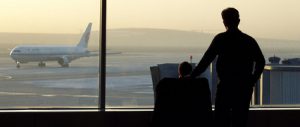There are three levels at which China can respond to this challenge from Europe: legal, political and technical. I put the legal process at the top of the list, as it is the most reliable, and should start immediately. It can also become a bargaining chip in the political process. Lessons can be taken from the approach of the United States, where aviation industry associations and airlines are taking joint legal action. While using the Chicago Convention as a basis for action is problematic, as we saw in part one, the Chinese argument can focus on three other points.
First, the airlines can make use of regulations included in EU-China aviation agreements, in particular those related to fuel duties. Second, they can argue that the requirement that developing-nation airlines pay the same charges as European airlines is a breach of the principle of common but differentiated responsibilities set out in the Kyoto Protocol, which seeks to ensure rich nations bear a greater share of the burden in addressing climate change. According to that principle the responsibilities of airlines of developing nations including China should be different from those of airlines of developed nations, such as those within the European Union. The EU’s climate responsibilities are compulsory, while those of developing nations are voluntary and based on their degree of economic and social development.
Third, the climate targets set for international airlines by the European Union are higher than the global target set by the United Nations’ International Civil Aviation Organization (ICAO). In October 2010, the ICAO 37th Assembly produced a global emissions-reduction plan for the aviation industry, committing it to increasing fuel efficiency by 2% annually until 2050; establishing a global framework for promoting the development and use of sustainable replacement fuels; and producing a global standard for airplane carbon emissions by 2013.
Negotiation
Politically, the time is right for proposing talks. The US Air Transport Association is determined to continue its legal action against Europe and the recent ICAO decisions described above appear to have had some impact on the EU policymakers, who are starting to relax their position. A statement on October 9 said the EU was open to constructive dialogue with third party countries during the implementation of the EU-ETS, in particular on handling flights into the trading bloc from outside.
The outcomes to aim for through such dialogue are as follows.
The ideal result would be to have aviation emission cuts restricted to EU airlines only. In particular, airlines of developing nations such as China should be excluded. This can be argued for on the basis of the principle of common but differentiated responsibilities, and supporting articles in bilateral aviation agreements.
If, however, China’s airlines are to be included, then the EU should be pressed to meet a number of conditions. These would include at the minimum the following four points. One, the release of a greater number of free emission permits, for example allowing a certain amount of growth every year until 2020, in order to guarantee that China’s airlines have room to expand in the EU market. Permits not used due to efficiency improvements or a reduction in the number of flights could be sold for profit on the EU carbon market.
Two, provision of technical support and aid from the European Union on aviation technology, carbon monitoring and management. Three, revenue from emission permits which China’s airlines are required to purchase in Europe should be earmarked for technical support for China. And four, China’s airlines should be allowed to purchase Chinese carbon offsets – certified by international bodies – such as forest carbon stores in the west of China as an equivalent to EU carbon permits. This would be a highly significant move, and is feasible.
If neither of the above outcomes can be agreed upon, then delayed entry to the EU-ETS can be requested – until the United Nations negotiation process reaches a legally-binding international climate agreement, for example; or until the ICAO reaches a deal specifying the actual aviation emission-reduction duties of individual nations. That would provide at least two or three years of space.
Finally, China can argue that the EU policy may create “carbon leakage”, the situation where an emissions-reduction policy in one country causes emissions to rise in another. Non-EU airlines may, to avoid purchasing emission permits, choose routes that avoid European airspace, for instance stopping in the Middle East – and thus increase aviation emissions.
Preparing the data
A response at the technical level is also very important, particularly on the issue of monitoring and checking airline emissions data.
It should be noted that, currently, all verification for the purposes of the EU-ETS must be done by EU-certified, independent, third-party verification bodies. According to industry insiders, these bodies usually verify emissions of factories and other facilities – they have no experience verifying aviation data. Nor is there yet a clear price-tag for verification of aviation emissions, as these bodies are unclear as to whether European verification staff will need to travel to China.
I believe it is essential that, prior to third-party verification, the airlines themselves establish highly capable and reliable teams to gather and analyse data to ensure as far as possible that data is beneficial for the airlines. Data for 2010 will not just determine quotas for 2012, but for at least the next nine years.
Turning to the WTO
On October 6, advocate general of the European Court of Justice Juliane Kokott issued a preliminary opinion on the US legal challenge, which found that the EU policy is valid. The court is likely to follow her opinion and rule that the EU-ETS is not in breach of international law.
However, members of the World Trade Organisation may argue that the EU directive still violates WTO rules, and if they make a case on these grounds, the EU Directorate-General for Trade may intervene. That legal process has not yet started, but if the EU’s directive is implemented as planned next year, then countries including China and the United States may take the case to the WTO.
But that process is much more complicated. WTO disputes are government affairs – industry associations and airlines cannot bring a case themselves. Moreover, WTO dispute resolution can only apply to existing policies, and when there is clear evidence that the policy has caused harm to the complainant. As the aviation ETS is not yet in operation, it is not yet possible to go down this path.
Cheng Shuaihua runs the Strategic Analysis Department at the International Centre for Trade and Sustainable Development (ICTSD).
This article was originally published on the ICTSD’s Chinese website and is reproduced here with permission. Some information has been updated following consultation with the author. The views expressed in this article are the author’s own and do not represent those of, and should not be attributed to, his organization.
Part one: China’s worst case scenario.
Homepage image by World Economic Forum shows José Manuel Barroso, president of the European Commission.





